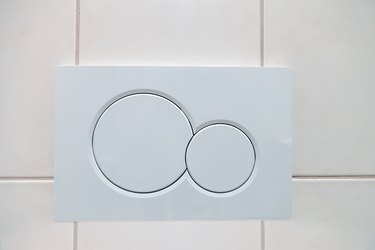
A dual-flush toilet presents a homeowner with the ability to conserve water in the bathroom. The toilet has two flush options: a smaller flush for liquid waste and a larger flush for solid waste. This reduces the amount of water used overall, which not only helps the environment but lowers the water bill substantially. Because of the way they're set up, dual-flush toilets can have the same issues standard-flush toilets do, but they can also have problems distinctly resulting from their design.
Dual-Flush Toilet Issues
Video of the Day
The most common problem dual-flush toilets have is clogging. Even though the flush for solid waste is the standard size, every flush for liquid waste uses a smaller volume of water. This can lead to stagnation in the pipes if they weren't necessarily designed for this sort of system, especially in a bathroom that doesn't see constant use like a guest bathroom or basement toilet. The solution is to balance the desired water conservation with the strength of flush needed to ensure the lines remain free of clogs.
Video of the Day
Troubleshooting Dual-Flush Toilets
To troubleshoot these issues, the first thing to do is define the problem. What's wrong with the toilet's function? Is the tank running when not in use? Do the lines seem clogged? Is the water level too high or too low? Once you've determined the issue, walk through the following steps to troubleshoot before calling a plumber.
Toilet Doesn't Flush Properly
If the toilet doesn't flush, check the flush mechanism inside the tank. If the flush valve chain has become detached from either the flush lever or the flush ball, the toilet won't flush when the lever is turned. Make sure there isn't a lot of slack on the chain so the flush ball will lift when the toilet is flushed.
If the toilet isn't flushing sufficiently, adjust the water level in the tank using the float. Fully open the water supply shut-off valve to allow full pressure to the flush and to fill the tank more quickly. Check to see if the added pressure helps the flush.
If the toilet is too noisy when flushing, close the water supply valve a bit to reduce the pressure going into the flush. Try a sample flush and continue to adjust until the flush seems adequate.
Running or Water-Level Issues
If the toilet runs between uses, check the seal on the flush ball. Regular wear and tear can cause cracks or damage to the rubber, which can interfere with the seal. If the flush ball is damaged or worn or if the flush mechanism itself is rusted or worn, replace the entire mechanism.
If the toilet doesn't drain or overflows, the first troubleshooting step is a plunger. Try to clear out the clog and flush the toilet again until the bowl is clear. If this doesn't work, there may be an issue where waste has settled into a sag or dip in a pipe and is clogging the line. Bringing in a professional plumber is recommended.
Many of these issues are easy enough to fix once you've pinpointed the problem. If the problem seems bigger than these, or if you can't resolve the issue on your own, be sure to call a professional plumber to come and investigate.